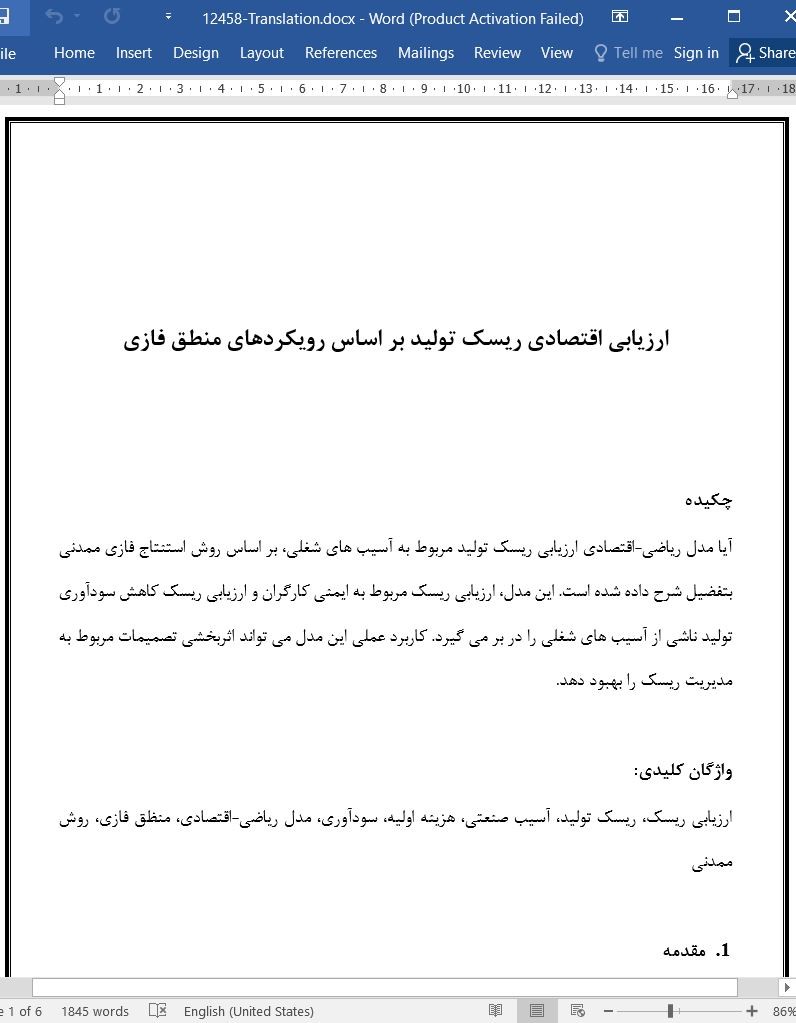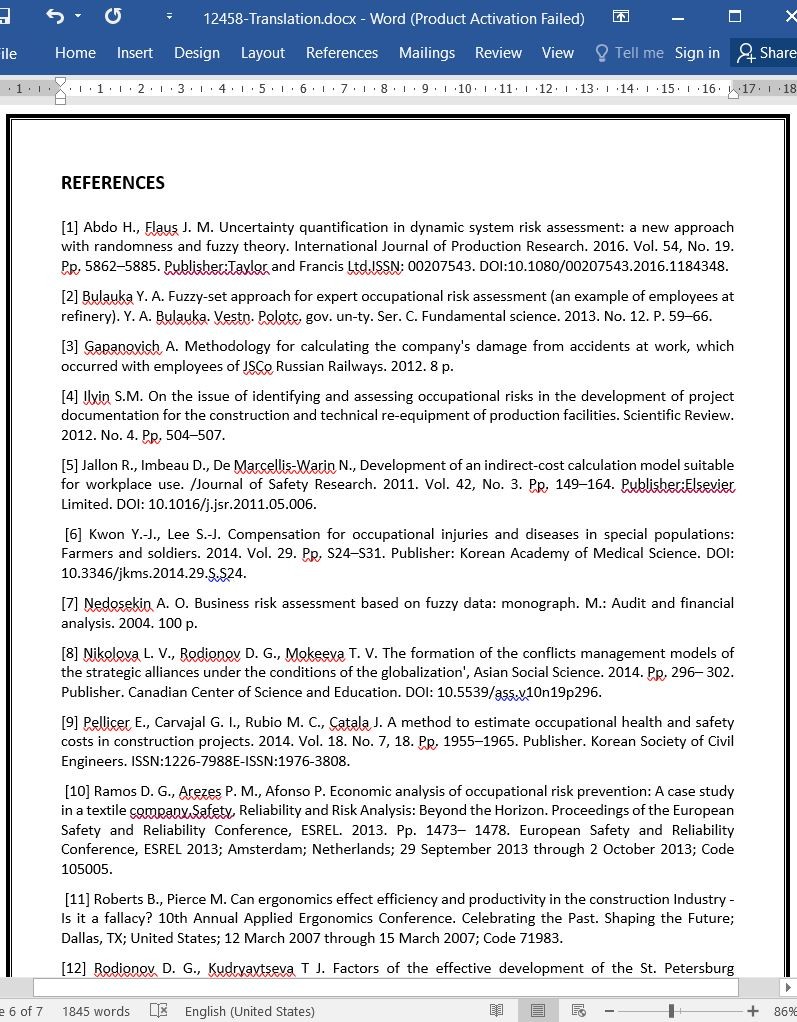
دانلود مقاله ارزیابی اقتصادی ریسک تولید بر اساس رویکردهای منطق فازی
چکیده
آیا مدل ریاضی-اقتصادی ارزیابی ریسک تولید مربوط به آسیب های شغلی، بر اساس روش استنتاج فازی ممدنی بتفضیل شرح داده شده است. این مدل، ارزیابی ریسک مربوط به ایمنی کارگران و ارزیابی ریسک کاهش سودآوری تولید ناشی از آسیب های شغلی را در بر می گیرد. کاربرد عملی این مدل می تواند اثربخشی تصمیمات مربوط به مدیریت ریسک را بهبود دهد.
1. مقدمه
رقابت پذیری یک شرکت عمدتا توسط کمیت و کیفیت نیروی کار، سرمایه گذاری در تولید محصولات تعیین می شود. توسعه پایدار به افزایش بهره وری نیروی کار، کاهش هزینه ها و اثربخشی شرکت بستگی دارد. در روسیه، آسیب اقتصادی ناشی از کاهش ظرفیت نیروی کار کارگران در اثر قرار گرفتن در معرض عوامل پرخطر تولید(HPF) در حال افزایش است. تجربه کشورهای صنعتی نشان می دهد که پرخطر بودن محیط کار و نرخ بالای رخداد صدمات صنعتی با کسب و کار موفق ارتباطی ندارد، زیرا این عوامل موجب زیان های زیادی برای شرکت می شوند.
5. نتیجه گیری
مدل ارائه شده، ایجاد ارزیابی جامع از ریسک مربوط به آسیب های شغلی را امکان پذیر می سازد. ابتدا، این مدل را می توان برای ارزیابی ریسک حادثه ناشی از در معرض HPF قرار گرفتن، به کار برد، بر اساس داده هایی در زمینه احتمال وقوع، دقت نتایج و زمان تاثیر هر HPF خاص در محل کار. دوم، بر اساس این مدل می توان نتیجه گرفت، چگونه شرکت در ارتباط با حوادث شغلی متحمل هزینه می شود که بر هزینه اولیه و سودآوری تولید تاثیر گذار خواهد بود.
بنابراین، ریسک های تولید ناشی از آسیب های صنعتی را می توان به پنج گروه اصلی طبقه بندی کرد. استفاده از این مدل وظیفه تصمیم گیری اجتماعی و از نظر اقتصادی موجه مدیریت ریسک تولید را برای صاحبان کسب و کار بهینه می کند، تا به اهداف شرکت دست یابند.
Abstract
Has elaborated economically-mathematical model of assessing the production risk associated with occupational injuries, based on the Mamdani's fuzzy inference method. The model includes assessment of risk associated with workers' safety and the risk assessment of the production profitability reducing due to occupational injuries. The practical application of the model can improve the effectiveness of decisions taken to manage risk.
I. INTRODUCTION
The competitiveness of an enterprise is largely determined by the quality and quantity of labor, invested in the manufacture of products. Sustainable development is based on increasing labor productivity, reducing costs and effectivization of the enterprise. Economic damage of workers' loss of labor capacity as a result of exposure to hazardous production factors (HPF)in Russia is growing. Industrialized countries experience demonstrates that harmful work-related exposure and high occurrence rate of industrial injuries cannot be satellites of prosperous business, as they cause eyewatering enterprise losses.
V. CONCLUSION
The proposed model allows making a comprehensive assessment of the enterprise's risk associated with occupational injuries. Firstly, it can be used to assess the risk of an accident from exposure to HPF, based on the data on likelihood of occurrence, severity of consequences and duration of the impact of each specific HPF in the workplace. Secondly, the model makes it possible to conclude how the enterprise expenses associated with the occupational accident will affect the prime cost and the profitability of production.
Thus, enterprise production risks, caused by industrial injuries, are flexibly classified into five main groups. The application of this model rationalizes for the business-owner the task of making an economically justified and socially oriented decision of the production risk management, that meets the strategic goals and objectives of the enterprise.
چکیده
1. مقدمه
2. پیشینه ایجاد مدلی برای ارزیابی ریسک
3. ارزیابی مولفه ریسک تولید
4. ارزیابی ریسک اقتصادی
5. نتیجه گیری
منابع
Abstract
1. INTRODUCTION
2. BACKGROUND OF FORMING THE RISK ASSESSMENT MODEL
3. ASSESSMENT OF THE PRODUCTION RISK COMPONENT
4. ECONOMIC RISK ASSESSMENT
5. CONCLUSION
REFERENCES
- ترجمه فارسی مقاله با فرمت ورد (word) با قابلیت ویرایش، بدون آرم سایت ای ترجمه
- ترجمه فارسی مقاله با فرمت pdf، بدون آرم سایت ای ترجمه



